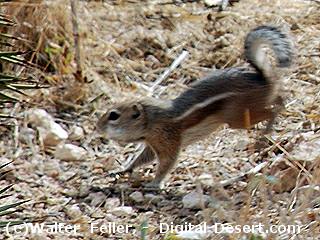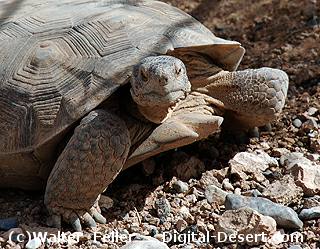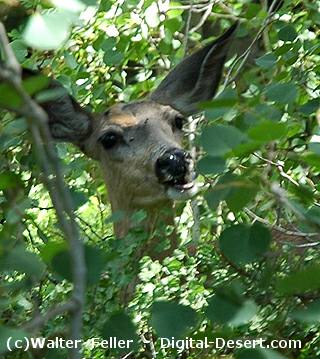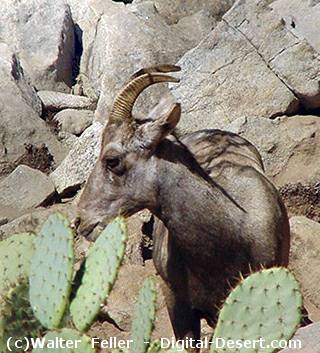Herbivores
Plant-eaters form the foundation of desert life. Every coyote, hawk, and snake depends on them, directly or indirectly. By nibbling seeds, clipping leaves, and trimming shrubs, herbivores shape the desert landscape, keeping plants from overrunning one another and helping scatter seeds far and wide. In turn, they provide the energy that keeps the desert food chain moving. From tiny rodents to mountain-climbing bighorns, each has its own way of surviving where water is scarce and the sun shows no mercy.Small Herbivores
Antelope Ground SquirrelIf you see a small gray streak racing across the sand at high noon, tail raised like a little white flag, that’s the antelope ground squirrel. One of the few mammals that stays active in the midday heat, it cools off by lying flat on shaded soil, pressing its belly to the ground. Green leaves and morning dew supply the water it needs to replace what it loses in the heat.
Kangaroo Rat
This desert specialist never drinks water — not once in its life. Every bit of moisture comes from the seeds it eats and the digestion process itself. Its body is fine-tuned to conserve every drop, reclaiming water from its breath and producing almost no waste. During the day it stays cool underground, where it stores seeds that soak up moisture before mealtime.
Pack Rat
Also called a woodrat, this collector builds large stick nests near cactus and rocks, often decorating them with shiny odds and ends it finds. It feeds on cactus pads, leaves, and seeds, and its nests may be used for many generations.
Black-tailed Jackrabbit
A fast runner with enormous ears, the jackrabbit is actually a hare. Those ears work like built-in radiators, releasing body heat. During the day it rests in shallow hollows near shrubs called “forms,” then ventures out at dusk to feed on grasses and desert plants.
Desert Cottontail
Rounder and smaller than a jackrabbit, the desert cottontail prefers brushy canyons and dry washes. It spends the day in burrows and feeds in the evening. Though cottontails breed often, their numbers stay balanced through predators and disease.
Large Herbivores
Mule DeerUsually found in foothills and washes, mule deer browse on shrubs and grasses. They feed mostly at night and visit springs or seeps for water. At dusk, they move quietly through the brush, almost ghost-like in the fading light.
Desert Bighorn Sheep
The bighorn is the desert’s climber, living among steep, rocky slopes where it can escape danger. It rarely strays more than a couple miles from water, and after summer rains, it follows temporary pools as long as they last. Rams’ curled horns grow throughout life and bear marks from head-butting contests during mating season.
Burro
Descended from donkeys brought by the Spanish, burros are hardy survivors. They can lose a third of their body water and recover it in minutes after finding water. Tough as they are, burros can damage fragile desert plants by grazing too heavily. Still, they remain a living link to the region’s mining past, when these sure-footed animals carried supplies across the Mojave.
More about:
Desert Cottontail
Desert Bighorn Sheep
Desert Tortoise
Antelope Squirrel
Wild Burro
Chuckwalla
Gambel's Quail
Mourning Dove
Jackrabbit

White-tailed antelope ground squirrel

Desert Tortoise
|
The Desert Food Chain * Everything has its niche. Who eats what, and what eats who in the desert? Click here to find out what more. |

Mule deer

Desert bighorn sheep